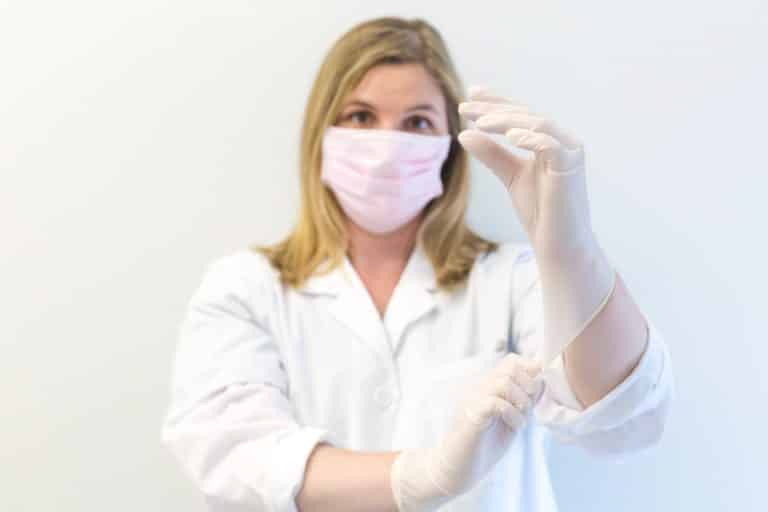CNA Basic Nursing Skills 1
The nurse aide sees a client spill water on the floor in the hall. Another client is walking down the hall. The nurse aide SHOULD
Falls can lead to serious injury and complications, especially among elderly or very ill clients. Every staff member should be constantly alert for potential hazards, including spills, and immediately take care of the situation. Never ignore the possible source of a fall. If the spill is caused by blood or body fluid, follow the protocol for decontamination and wear Personal Protective Equipment (PPE).
When transferring a client, MOST of the client’s weight should be supported by the nurse aide’s
When transferring a client, the nurse aide should be positioned to support the client by using the legs. Keep your back straight and locked; do not turn or twist. If you bend, do so at the hips, not the waist. Before beginning the transfer, assess how much the client is able to do. If you have any doubts, always ask for assistance from a co-worker.
The period of heart muscle contraction is called
Systole (pronounced “SIS-toe-lee”) is the time when the heart muscles contract, sending oxygenated blood to the body. It produces the first sound heard when taking a blood pressure, called the systolic pressure.
The nursing care plan states, “Transfer with mechanical lift.” however, the client is very agitated. To transfer the client, the nurse aide SHOULD
Client safety is always the top priority. When a patient is not able to cooperate for any reason, do not try to accomplish a task alone. It is important to follow the nursing care plan, including all steps of operating any equipment being used to move or transfer the client. Ask a co-worker to help if you have any concerns about keeping the client safe. If the client remains agitated, notify the nurse before proceeding.
The first sign of a decubitis ulcer is
One of the primary responsibilities of a nurse aide is to monitor the client’s skin for any signs of breakdown. During baths, dressing, or position changes, inspect the skin for redness, pallor, warmth, or bruising. Reposition at least every two hours, protecting areas that rub together, as well as the bony prominences. Massages to the back and buttocks can promote circulation. Range-of-motion exercises are also helpful. Always report any signs of breakdown to the nurse.
The nurse aide notices that the client’s radio cord is draped across a chair in order to reach the nearest outlet. The FIRST thing the nurse aide should do is
All facilities must comply with the electrical safety standards of governmental and accrediting agencies. Client devices, including radios or televisions, must be approved according to the facility’s policies. Cords cannot cause any potential hazards, such as tripping or falls. Extension cords are usually not allowed. The nurse aide can help the client find a place for the radio where the cord to be safely plugged in, so the client can continue to enjoy listening.
The equipment you need to gather to do unconscious oral care would include
Because an unconscious client is not able to assist with oral care, the nurse aide must take extra precautions to prevent choking or aspirating while giving oral care. The client’s head should be turned to the side. If possible, lower the head of the bed. Gently clean the teeth and gums with a separate moist toothette or mouth swab for each area of the mouth. Wipe the client’s mouth when finished and raise the head of the bed to its prior position.
The case manager for a client requiring home health care is usually done by
Home health agencies employ registered nurses to manage client care. While a physician gives orders and is always available for consultation, the RN oversees the daily care by the home health staff. Home health agencies follow strict guidelines to maintain their accreditation.
When taking an oral temperature, it is important to
To take an oral temperature, make sure the client has not had anything hot or cold to eat or drink for 15 minutes. Place the thermometer under the client’s tongue. A digital thermometer will beep when it registers the client’s temperature. A glass thermometer will have a line that stops moving when it gives the reading. In an adult, a fever is considered to be greater than 38 degrees C (100.4 degrees F). For children, a fever is 37.5 degrees C (99.5 degrees F).
Which statement best describes ADL’s
Activities of Daily Living (ADLs) are the basic personal tasks that can be done without help. There are six tasks: eating, bathing, dressing, personal hygiene, mobility, and using the toilet. As long as the client can perform these tasks, even with special tools or devices, they are considered independent. A way to remember the ADLs is “DEATH” which stands for D=Dress, E=Eat, A=Ambulate, T=Transfer/Toilet, H=Hygiene.
The electric shaver that the nurse aide is using to shave a client begins to spark and smoke. What should the nurse aide do FIRST?
Whenever giving client care, remember that the patient’s safety comes first. Unplugging a malfunctioning device will stop any sparks or smoke. If the client, or anyone nearby, is on oxygen, the sparks could trigger a fire, so you may need to quickly move people out of the area. After everyone is safe, notify the nurse of the incident. Never use another client’s personal items; this is strictly prohibited because of possible infection.
To convert four ounces of juice to milliliters (ml), the nurse aide should multiply
When converting milliliters (ml) to ounces (oz) remember that 30 ml = 1 ounce. Although an ounce is slightly more, the amounts are considered to be equal by doctors and pharmacists.
When making an occupied bed, the nurse aide should always
Making an occupied bed involves changing the bed linens while keeping the patient comfortable. Use a privacy sheet to cover the patient during the process. Always raise the side rail on the opposite side of where you are working to prevent the patient from rolling out or falling.. If the patient is able, they can hold onto the side rail. Adjust the bed height to avoid injuring your back. Return the bed to its lowest level when you are finished.
Rheumatoid arthritis may
Rheumatoid Arthritis (RA) is an autoimmune disease. The patient’s immune system attacks the lining of the membranes that surround the joints, causing severe pain, swelling, redness, and muscle spasms. Over time, the joints become deformed. There can be periods of remission, but there is no cure for RA.
An apical pulse is counted for _______.
An apical pulse is taken on the patient’s chest near the heart. You will need a stethoscope and a stopwatch to count for one full minute. An apical pulse is useful for slow pulse rates (under 60 bpm) or irregular pulse rates.
The nurse aide is walking with a client confined to a wheelchair when the facility fire alarm system is activated. The client becomes excited from the noise. The nurse aide SHOULD
The nurse aide should be familiar with all fire safety policies and protocols. When a fire alarm sounds, all staff must respond to keep clients safe. Remember “R.A.C.E.” to quickly act. R = Rescue/Remove all people who can not take care of themselves. A = Alarm, if it has not already been done. Pulling the alarm can be done at the same time as rescue. C = Confine/Contain the fire or smoke by closing doors to prevent or slow the spread. Smoke is especially dangerous for everyone. E = Extinguish the fire if possible, using a handheld fire extinguisher. Attempt to extinguish only small fires, as long as you can remain safe and have an escape route.

